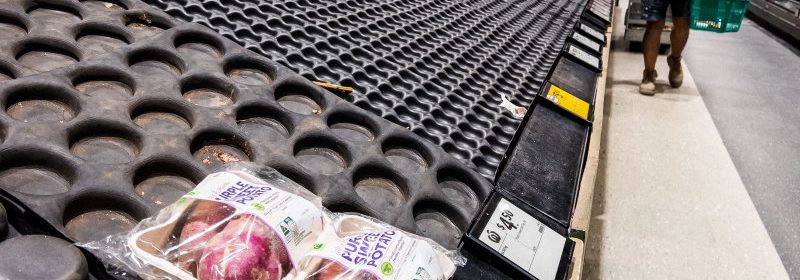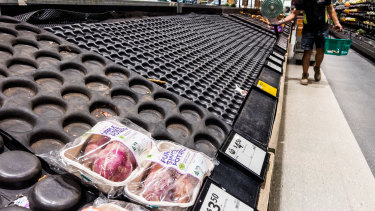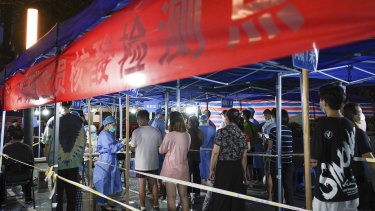Global supply chain pressures ease, but crisis isn’t over

For our free coronavirus pandemic coverage, learn more here.
The nature of global supply chains is so complex and multi-faceted that it is difficult to get a fix on just how disrupted they have been by the pandemic.
We can see the end-result – the queues of container ships at ports, the empty shelves at supermarkets and other retailers, the rising cost of goods, the extended waiting times for deliveries — but it is difficult, if not impossible, to bring together all the intricate strands that connect producers to consumers in a globalised trade environment.
Empty fresh produce shelves at Woolworths in Sydney’s Neutral Bay on Friday.Credit:James Brickwood
Last week the New York Federal Reserve made a stab at doing just that, launching what it calls the Global Supply Chain Pressure Index (GSCPI). The index uses two cross-border indices for transportations costs – the Baltic Dry Index (which measures the cost of shipping bulk commodities) and the Harpex index (which tracks shipping container costs) – along with other indices measuring the cost of air freight and a host of country-specific purchasing managers’ data that captures factory delivery times, orders yet to be fulfilled and inventory levels.
With 27 variables, the credibility and utility of the GSCPI could be questioned but the index does appear to reflect the anecdotal evidence of the trajectory of the supply chain crisis over the past two years.
There’s an initial spike in the index in early 2020 as China imposed widespread and severe lockdowns – a preview of its “zero COVID” approach to the pandemic – and then, after a brief fall in the index, a much bigger spike to levels not experienced in the quarter of a century of the data the Fed’s researchers based the index on as COVID began raging around the world.
Around October/November last year the index started to fall back, albeit to still-elevated levels, which fits with the movements in the Baltic Dry and Harpex indices and broader economic statistics.
While that might suggest the supply chain crisis has peaked it would be premature, and almost certainly wrong, to say that it is over.
The impact of the Omicron variant on domestic supply chains here – the acute shortages of labour and the severed disruption that is causing to domestic supply chains and availability of goods and services – are evidence of the continuing threat to the complex domestic and external logistics that underpin a modern economy.
New outbreaks in China have seen an entire city of nearly 13 million people forced into extreme lockdown while the operations at the world’s third-largest container port, Ningbo, have been disrupted (again) by an outbreak of COVID in one of its suburbs that is impacting trucking into and out of the port.
China operates seven of the world’s 10 largest container ports so its hardline approach to the pandemic has routinely disrupted international trade, as have the effects of the pandemic and, more recently, an energy crisis, on its factories.
People line up for COVID-19 tests at a testing station in Nanjing in eastern China’s Jiangsu Province.Credit:AP
Similarly, labour shortages due to COVID infections and risk-aversion have impacted US ports and land transport capacity, leading to long queues at ports and lengthy turnaround times for cargo ships and delayed and volatile flows of goods to US companies and consumers.
It’s also seen spikes in shipping and container costs, which soared to as much as 10 times pre-pandemic levels before subsiding somewhat late last year, which in turn is being passed on to companies and their end consumers. Shipping accounts for about 90 per cent of the cross-border transport of goods.
The dislocations to global supply chains coincided with an enormous increase in consumer demand, partly fuelled by the largesse of governments and central banks but also the impact of lockdowns on where consumers could spend their savings – the lockdowns hit travel, entertainment and restaurants particularly hard.
Disrupted supply and greatly increased and distorted (relative to pre-pandemic spending patterns) demand helped generate the global surge in inflation rates to levels not seen in decade that is now forcing U-turns in the unprecedented, ultra-loose monetary and fiscal policies the major economies deployed in response to the pandemic.
While some of the supply chain pressures and costs captured by the GSCPI may have subsided from their 2021 peaks (the cost of shipping containers from China to the west coast of the US is 30 per cent off its peak) it is obvious that the continuing outbreaks and mutations of COVID and the responses of companies and consumers to the pandemic means there will be no reversion to the pre-pandemic norm, even if the pandemic is ultimately brought under control.
Globalisation, the emergence of China as the world’s low-cost manufacturing base and the seamless movement of goods and services around the world before 2020 enabled companies to be comfortable pursuing the “just in time” low-inventories production strategies pioneered by the Japanese in the 1970s.
After the experience of the past two years – of both the pandemic and the increasing tensions between China and the West – corporate strategies will shift from that just in time, lean manufacturing approach to one of “just in case.”
They will hold more inventory and source or manufacture closer to home, either absorbing the increased costs or, for those with pricing power, passing them on to consumers.
It is likely that companies – the transport companies and the factories and customs they connect – will already be responding to their experiences, which probably explains why the GSCPI started to decline towards the end of last year.
It is improbable, however, that the index will fall back from its peak of four standard deviations from its long-term average to pre-pandemic norms.
There are supply chain experts who believe that a new and functioning normal for global supply chains will be achieved within the next two years. Whenever that new normal is achieved, and whatever it looks like, it appears certain it will look and operate differently, and cost more, than the one the pandemic has displaced.
The Morning Edition newsletter is our guide to the day’s most important and interesting stories, analysis and insights. Sign up here.
Most Viewed in Business
From our partners
Source: Read Full Article


